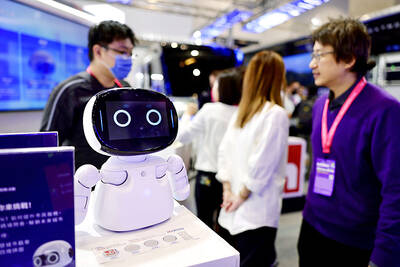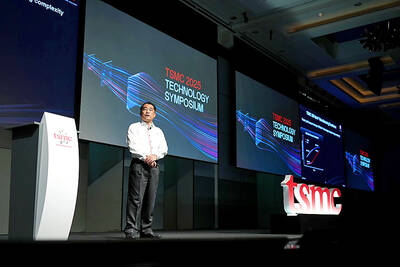China’s economy grew at its slowest pace in at least a decade in the first quarter, but stronger industrial activity added to tentative signs the slump might be bottoming out amid huge stimulus spending.
The world’s third-largest economy grew by 6.1 percent from a year earlier as the global crisis battered trade, down from 6.8 percent in the previous quarter, the government reported yesterday.
Overall growth “is below expectations but positive signs are emerging that the economy possibly is bottoming out,” Credit Suisse economist Dong Tao (陶冬) said.
Industrial output surged 8.3 percent last month from a year earlier, up from 3.8 percent growth in the first two months of the year, said Li Xiaochao (李曉超), a spokesman for the National Bureau of Statistics. Investment in factories and other fixed assets soared 28.6 percent from a year earlier.
Quarterly growth appeared to be the lowest in at least a decade, though China has repeatedly revised its historical data, making comparisons difficult. Analysts said the 6.8 percent growth in the previous quarter was the lowest since 2001 and possibly earlier.
Beijing worries that rising job losses because of the crisis will fuel unrest and its priority is creating jobs for millions of unemployed people. Some analysts say 8 percent growth — China’s official target for this year — is the minimum needed to create enough employment. But others say the government should focus on job creation, not overall growth, because stimulus spending might inflate growth numbers without adding enough jobs.
Other areas have shown tentative improvements, with auto sales hitting a monthly high last month. But Premier Wen Jiabao (溫家寶), China’s top economic official, has cautioned that a possible rebound is fragile and called for vigilance and more efforts to boost growth.
The World Bank and some economists see a Chinese recovery starting this year but say that will depend partly on whether demand in the US and other Western markets recovers. The World Bank is forecasting Chinese growth of 6.5 percent this year.
Also See: US economy contracts further

DEMOGRAPHICS: Robotics is the most promising answer to looming labor woes, the long-term care system and national contingency response, an official said Taiwan is to launch a five-year plan to boost the robotics industry in a bid to address labor shortages stemming from a declining and aging population, the Executive Yuan said yesterday. The government approved the initiative, dubbed the Smart Robotics Industry Promotion Plan, via executive order, senior officials told a post-Cabinet meeting news conference in Taipei. Taiwan’s population decline would strain the economy and the nation’s ability to care for vulnerable and elderly people, said Peter Hong (洪樂文), who heads the National Science and Technology Council’s (NSTC) Department of Engineering and Technologies. Projections show that the proportion of Taiwanese 65 or older would

Nvidia Corp yesterday unveiled its new high-speed interconnect technology, NVLink Fusion, with Taiwanese application-specific IC (ASIC) designers Alchip Technologies Ltd (世芯) and MediaTek Inc (聯發科) among the first to adopt the technology to help build semi-custom artificial intelligence (AI) infrastructure for hyperscalers. Nvidia has opened its technology to outside users, as hyperscalers and cloud service providers are building their own cost-effective AI chips, or accelerators, used in AI servers by leveraging ASIC firms’ designing capabilities to reduce their dependence on Nvidia. Previously, NVLink technology was only available for Nvidia’s own AI platform. “NVLink Fusion opens Nvidia’s AI platform and rich ecosystem for

Taiwan Semiconductor Manufacturing Co (TSMC, 台積電) yesterday said it is building nine new advanced wafer manufacturing and packaging factories this year, accelerating its expansion amid strong demand for high-performance computing (HPC) and artificial intelligence (AI) applications. The chipmaker built on average five factories per year from 2021 to last year and three from 2017 to 2020, TSMC vice president of advanced technology and mask engineering T.S. Chang (張宗生) said at the company’s annual technology symposium in Hsinchu City. “We are quickening our pace even faster in 2025. We plan to build nine new factories, including eight wafer fabrication plants and one advanced

‘WORLD’S LOSS’: Taiwan’s exclusion robs the world of the benefits it could get from one of the foremost practitioners of disease prevention and public health, Minister Chiu said Taiwan should be allowed to join the World Health Assembly (WHA) as an irreplaceable contributor to global health and disease prevention efforts, Minister of Foreign Affairs Lin Chia-lung (林佳龍) said yesterday. He made the comment at a news conference in Taipei, hours before a Taiwanese delegation was to depart for Geneva, Switzerland, seeking to meet with foreign representatives for a bilateral meeting on the sidelines of the WHA, the WHO’s annual decisionmaking meeting, which would be held from Monday next week to May 27. As of yesterday, Taiwan had yet to receive an invitation. Taiwan has much to offer to the international community’s